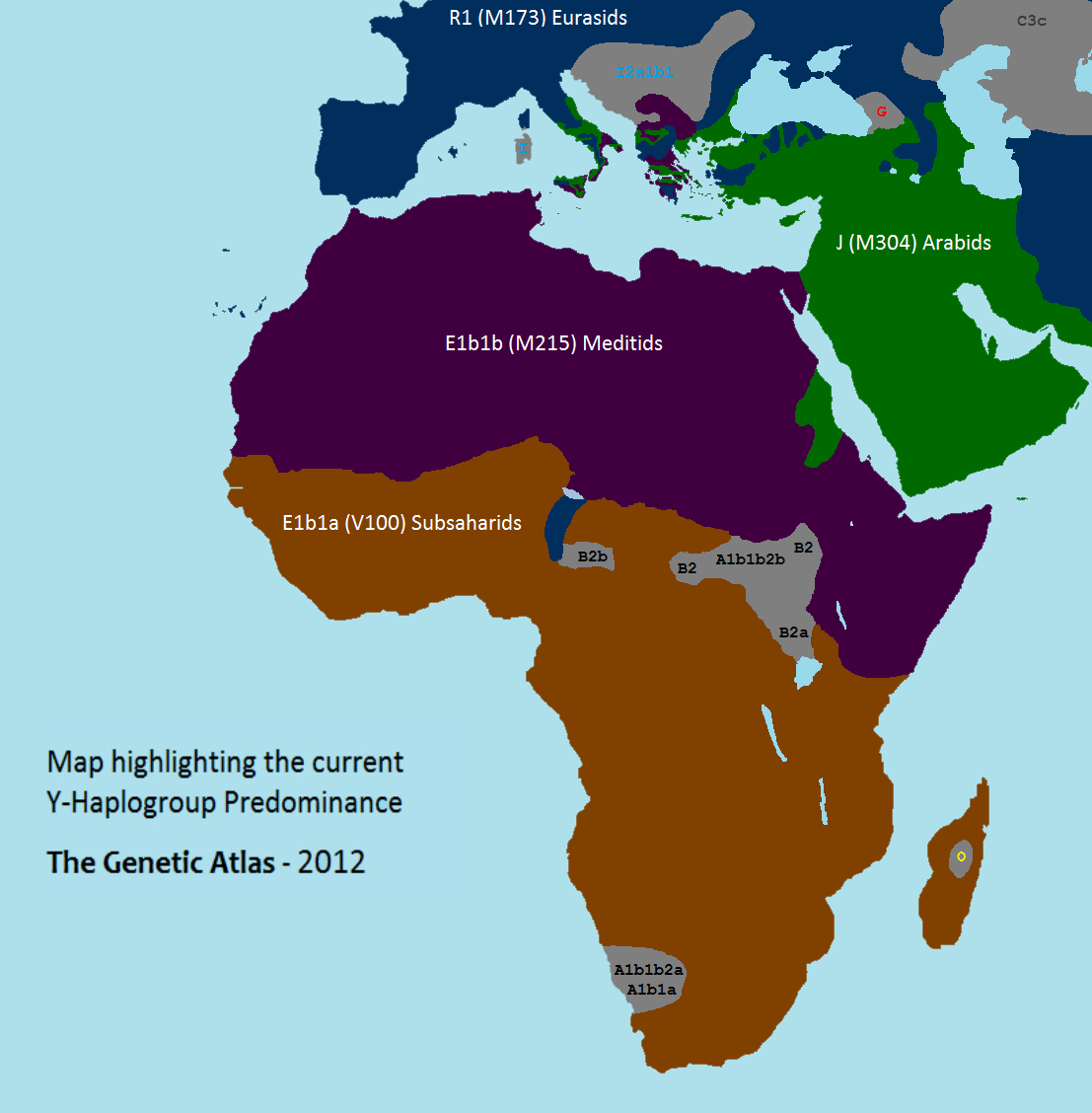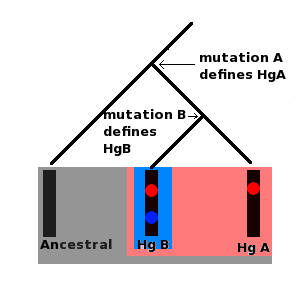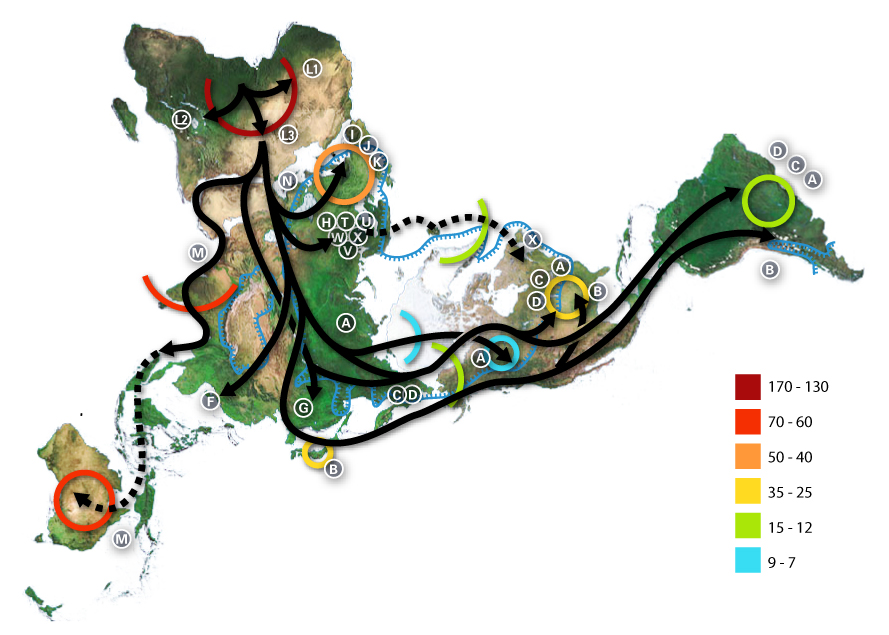|
Haplogroup E-P147
In human genetics, Haplogroup E-P147 is a human Y-chromosome DNA haplogroup. Haplogroup E-P147, along with the less common Haplogroup E-M75, is one of the two main branches of the older Haplogroup E-M96. The E-P147 clade is commonly observed throughout Africa and is divided into two subclades: the less common E-M33 & the more common E-P177. Origin Distribution The Polymorphism P147 was first discovered in 2008 and contains the vast majority of men who belong to E-M96. The two branches of this lineage have different distributions, while the less common branch, E-M33, has more of a West African distribution, the more common branch, E-P177, can be found widely distributed with high frequency throughout Africa and to a lesser extent in the Middle East and Europe Europe is a large peninsula conventionally considered a continent in its own right because of its great physical size and the weight of its history and traditions. Europe is also considered a Continent#Subcontin ... [...More Info...] [...Related Items...] OR: [Wikipedia] [Google] [Baidu] |
Haplogroup E (Y-DNA)
Haplogroup E-M96 is a human Y-chromosome DNA haplogroup. It is one of the two main branches of the older and ancestral haplogroup DE, the other main branch being Haplogroup D (Y-DNA), haplogroup D. The E-M96 clade is divided into two main clades, subclades: the more common Haplogroup E-P147 (Y-DNA), E-P147, and the less common Haplogroup E-M75 (Y-DNA), E-M75. Origins Underhill (2001) proposed that haplogroup E may have arisen in East Africa. Some authors as Chandrasekar (2007), accept the earlier position of Hammer (1997) that Haplogroup E may have originated in West Asia, given that: * E is a clade of Haplogroup DE, with the other major clade, Haplogroup D (Y-DNA), haplogroup D, being exclusively distributed in Asia. * DE is a clade within Haplogroup CT (Y-DNA), M168 with the other two major clades, C and F, considered to have already a Eurasian origin. However, several discoveries made since the Hammer articles are thought to make an Asian origin less likely: # Underhill and K ... [...More Info...] [...Related Items...] OR: [Wikipedia] [Google] [Baidu] |
Haplogroup E-P2
E-P2, also known as E1b1, is a human Y-chromosome DNA haplogroup. This paternal clade had an ancient presence in the Middle East, and is now primarily distributed in Africa where it's believed to have originated, with lower frequencies in the Middle East and Europe. Origin Trombetta et al. 2011, suggest an origin in eastern Africa: The new topology here reported has important implications as to the origins of the haplogroup E-P2. Using the principle of the phylogeographic parsimony, the resolution of the E-M215 trifurcation in favor of a common ancestor of E-M2 and E-M329 strongly supports the hypothesis that haplogroup E-P2 originated in eastern Africa, as previously suggested, and that chromosomes E-M2, so frequently observed in sub-Saharan Africa, trace their descent to a common ancestor present in eastern Africa. Distribution Natufian fossils that were analysed for ancient DNA were found to carry the paternal haplogroup E1b1(xE1b1a1,E1b1b1b1) (1/5; 20%). ÔÇTable S6.1 ÔÇô Y-c ... [...More Info...] [...Related Items...] OR: [Wikipedia] [Google] [Baidu] |
Haplogroup E-M165
A haplotype is a group of alleles in an organism that are inherited together from a single parent, and a haplogroup ( haploid from the el, ß╝ü¤Ç╬╗╬┐ß┐Ž¤é, ''haplo├╗s'', "onefold, simple" and en, group) is a group of similar haplotypes that share a common ancestor with a single-nucleotide polymorphism mutation. More specifically, a haplogroup is a combination of alleles at different chromosomal regions that are closely linked and that tend to be inherited together. As a haplogroup consists of similar haplotypes, it is usually possible to predict a haplogroup from haplotypes. Haplogroups pertain to a single line of descent. As such, membership of a haplogroup, by any individual, relies on a relatively small proportion of the genetic material possessed by that individual. Each haplogroup originates from, and remains part of, a preceding single haplogroup (or paragroup). As such, any related group of haplogroups may be precisely modelled as a nested hierarchy, in which each set (h ... [...More Info...] [...Related Items...] OR: [Wikipedia] [Google] [Baidu] |
Haplogroup E-M107
A haplotype is a group of alleles in an organism that are inherited together from a single parent, and a haplogroup ( haploid from the el, ß╝ü¤Ç╬╗╬┐ß┐Ž¤é, ''haplo├╗s'', "onefold, simple" and en, group) is a group of similar haplotypes that share a common ancestor with a single-nucleotide polymorphism mutation. More specifically, a haplogroup is a combination of alleles at different chromosomal regions that are closely linked and that tend to be inherited together. As a haplogroup consists of similar haplotypes, it is usually possible to predict a haplogroup from haplotypes. Haplogroups pertain to a single line of descent. As such, membership of a haplogroup, by any individual, relies on a relatively small proportion of the genetic material possessed by that individual. Each haplogroup originates from, and remains part of, a preceding single haplogroup (or paragroup). As such, any related group of haplogroups may be precisely modelled as a nested hierarchy, in which each set (h ... [...More Info...] [...Related Items...] OR: [Wikipedia] [Google] [Baidu] |
Haplogroup E-M81
E-Z827, also known as E1b1b1b, is a major human Y-chromosome DNA haplogroup. It is the parent lineage to the E-Z830 and E-L19 subclades, and defines their common phylogeny. The former is predominantly found in the Middle East; the latter is most frequently observed in North Africa. E-Z827 is also found at lower frequencies in Europe, and in isolated parts of Southeast Africa. Subclades of E-Z827 and Distribution Family Tree The following phylogeny is based on the YCC 2008 tree and subsequent published research as summarized by ISOGG. *E-Z827 (Z827) - E1b1b1bISOGG 2015 **E-V257/L19 (L19, V257) - E1b1b1b1 ***E-PF2431 (PF2431) ****E-PF2438 *****E-Y10561 ******E-FGC18981 *******E-FGC38527 *******E-Y35933 *******E-FGC18960 ********E-Y33020 ********E-FGC18958 *****E-PF2440 ******E-PF2471 *******E-BY9805 ***E-M81 (M81) ****E-M81* ****E-PF2546 *****E-PF2546* *****E-CTS12227 ******E-MZ11 *******E-MZ12 *****E-A929 ******E-Z5009 *******E-Z5009* *******E-Z5010 *******E-Z5013 ********E-Z5 ... [...More Info...] [...Related Items...] OR: [Wikipedia] [Google] [Baidu] |
Haplogroup E-M148
A haplotype is a group of alleles in an organism that are inherited together from a single parent, and a haplogroup ( haploid from the el, ß╝ü¤Ç╬╗╬┐ß┐Ž¤é, ''haplo├╗s'', "onefold, simple" and en, group) is a group of similar haplotypes that share a common ancestor with a single-nucleotide polymorphism mutation. More specifically, a haplogroup is a combination of alleles at different chromosomal regions that are closely linked and that tend to be inherited together. As a haplogroup consists of similar haplotypes, it is usually possible to predict a haplogroup from haplotypes. Haplogroups pertain to a single line of descent. As such, membership of a haplogroup, by any individual, relies on a relatively small proportion of the genetic material possessed by that individual. Each haplogroup originates from, and remains part of, a preceding single haplogroup (or paragroup). As such, any related group of haplogroups may be precisely modelled as a nested hierarchy, in which each set (h ... [...More Info...] [...Related Items...] OR: [Wikipedia] [Google] [Baidu] |
Haplogroup E-M78
Haplogroup E-V68, also known as E1b1b1a, is a major human Y-chromosome DNA haplogroup found in North Africa, the Horn of Africa, Western Asia and Europe. It is a subclade of the larger and older haplogroup, known as E1b1b or E-M215 (also roughly equivalent to E-M35). The E1b1b1a lineage is identified by the presence of a single nucleotide polymorphism (SNP) mutation on the Y chromosome, which is known as V68. It is a subject of discussion and study in genetics as well as genetic genealogy, archaeology, and historical linguistics. E-V68 is dominated by its longer-known subclade E-M78. In various publications, both E-V68 and E-M78 have been referred to by other names, especially phylogenetic nomenclature such as "E3b1a" which are designed to show their place on the family tree of all human males. These various names change as new discoveries are made and are discussed below. Origins E-M78, like its parent clade E-V68, is thought to have an African origin. Based on genetic STR ... [...More Info...] [...Related Items...] OR: [Wikipedia] [Google] [Baidu] |
Haplogroup E-M35
E-M215, also known as E1b1b and formerly E3b, is a major human Y-chromosome DNA haplogroup. It is a division of the macro-haplogroup E-M96, which is defined by the single-nucleotide polymorphism (SNP) mutation M215. In other words, it is one of the major patrilineages of humanity, linking from father-to-son back to a common male-line ancestor ("Y-chromosomal Adam"). It is a subject of discussion and study in genetics as well as genetic genealogy, archaeology, and historical linguistics. The E-M215 haplogroup has two ancient branches that contain all the known modern E-M215, E-M35 and E-M281 subclades. Of the latter two E-M215 subhaplogroups, the only branch that has been confirmed in a native population outside of Ethiopia is E-M35. E-M35 in turn has two known branches, E-V68 and E-Z827, which contain by far the majority of all modern E-M215 subclade bearers. The E-V257 and E-V68 subclades each respectively their highest frequencies in North Africa and the Horn of Africa, and ... [...More Info...] [...Related Items...] OR: [Wikipedia] [Google] [Baidu] |
Haplogroup E-M10
A haplotype is a group of alleles in an organism that are inherited together from a single parent, and a haplogroup ( haploid from the el, ß╝ü¤Ç╬╗╬┐ß┐Ž¤é, ''haplo├╗s'', "onefold, simple" and en, group) is a group of similar haplotypes that share a common ancestor with a single-nucleotide polymorphism mutation. More specifically, a haplogroup is a combination of alleles at different chromosomal regions that are closely linked and that tend to be inherited together. As a haplogroup consists of similar haplotypes, it is usually possible to predict a haplogroup from haplotypes. Haplogroups pertain to a single line of descent. As such, membership of a haplogroup, by any individual, relies on a relatively small proportion of the genetic material possessed by that individual. Each haplogroup originates from, and remains part of, a preceding single haplogroup (or paragroup). As such, any related group of haplogroups may be precisely modelled as a nested hierarchy, in which each set (h ... [...More Info...] [...Related Items...] OR: [Wikipedia] [Google] [Baidu] |
Haplogroup E-M155
A haplotype is a group of alleles in an organism that are inherited together from a single parent, and a haplogroup (haploid from the el, ß╝ü¤Ç╬╗╬┐ß┐Ž¤é, ''haplo├╗s'', "onefold, simple" and en, group) is a group of similar haplotypes that share a common ancestor with a single-nucleotide polymorphism mutation. More specifically, a haplogroup is a combination of alleles at different chromosomal regions that are closely linked and that tend to be inherited together. As a haplogroup consists of similar haplotypes, it is usually possible to predict a haplogroup from haplotypes. Haplogroups pertain to a single line of descent. As such, membership of a haplogroup, by any individual, relies on a relatively small proportion of the genetic material possessed by that individual. Each haplogroup originates from, and remains part of, a preceding single haplogroup (or paragroup). As such, any related group of haplogroups may be precisely modelled as a nested hierarchy, in which each set (hapl ... [...More Info...] [...Related Items...] OR: [Wikipedia] [Google] [Baidu] |
Haplogroup E-M154
A haplotype is a group of alleles in an organism that are inherited together from a single parent, and a haplogroup ( haploid from the el, ß╝ü¤Ç╬╗╬┐ß┐Ž¤é, ''haplo├╗s'', "onefold, simple" and en, group) is a group of similar haplotypes that share a common ancestor with a single-nucleotide polymorphism mutation. More specifically, a haplogroup is a combination of alleles at different chromosomal regions that are closely linked and that tend to be inherited together. As a haplogroup consists of similar haplotypes, it is usually possible to predict a haplogroup from haplotypes. Haplogroups pertain to a single line of descent. As such, membership of a haplogroup, by any individual, relies on a relatively small proportion of the genetic material possessed by that individual. Each haplogroup originates from, and remains part of, a preceding single haplogroup (or paragroup). As such, any related group of haplogroups may be precisely modelled as a nested hierarchy, in which each set (h ... [...More Info...] [...Related Items...] OR: [Wikipedia] [Google] [Baidu] |
Haplogroup E-M149
A haplotype is a group of alleles in an organism that are inherited together from a single parent, and a haplogroup ( haploid from the el, ß╝ü¤Ç╬╗╬┐ß┐Ž¤é, ''haplo├╗s'', "onefold, simple" and en, group) is a group of similar haplotypes that share a common ancestor with a single-nucleotide polymorphism mutation. More specifically, a haplogroup is a combination of alleles at different chromosomal regions that are closely linked and that tend to be inherited together. As a haplogroup consists of similar haplotypes, it is usually possible to predict a haplogroup from haplotypes. Haplogroups pertain to a single line of descent. As such, membership of a haplogroup, by any individual, relies on a relatively small proportion of the genetic material possessed by that individual. Each haplogroup originates from, and remains part of, a preceding single haplogroup (or paragroup). As such, any related group of haplogroups may be precisely modelled as a nested hierarchy, in which each set (h ... [...More Info...] [...Related Items...] OR: [Wikipedia] [Google] [Baidu] |



.png)

